Today I have a guest blog for you by my former intern Joey Percia. I vouch for all of these exercises; they’re my favorite for improving power. Great stuff right here!
The Most Under-Utilized Exercises for Developing Devastating Power
By Joey Percia
‘Olympic lifting is terrible, heavy barbell training is useless, sprinting sucks’.
Sound familiar?
Training to maximize power output becomes a very interesting topic when discussed amongst strength coaches. Some coaches swear by Olympic lifts and its variations, while others use a variety of approaches when seeking out maximal power development.
What is power?
Power is work divided by time ( P = work / time) and is a product of strength and speed. Research has shown that the optimum load for maximizing power production in a particular exercise depends on the movement being performed. Some studies show very little significant difference between loads (the Olympic lifts), while others have a much more obvious load that maximizes power (jump squats).
Someone that tells you that power is only developed at a certain percentage of your 1RM (for example, at 30% of 1RM), no matter what the exercise being performed, is misinformed. Some lifts are maximized at 0% of 1RM (jump squat), others at 30-70% of 1RM (bench throw, bench press, leg press, half squat, split jump squat), and others at 80% of 1RM and above (Olympic lift variations).
Considerations for Exercise Selection
Here are some important variables to account for when choosing exercises to develop devastating power.
1. Training Age
Choose exercises that coincide with an athlete’s training age — referring to the number of years they have been strength training. Those with a younger training age tend to show greater difficulty properly executing complicated exercises, in which case these should be avoided. Athletes spend a limited amount of time with a strength coach, which is why it is of great importance to perform exercises that will elicit the greatest gains (‘the most bang for your buck’).
Time is precious. It is a waste to prescribe frustrating and difficult tasks to athletes whose time spent with a strength coach is limited and valuable. Choose movements that are significantly easier to learn and perform yet are still highly beneficial.
2. Coach to Athlete Ratio
Monitor the athlete. Make sure form is correct and exercises are being performed safely and effectively. This is critical because the job of a coach depends on the athlete’s safety. Advanced movements and technical lifts which require different equipment and more coaching may not be optimal for settings other than one-on-one and small-group training. There is nothing wrong with performing these lifts if the proper amount of coaching is dedicated to each athlete.
3. Equipment Availability
Equipment is not just a common problem in commercial gyms. With larger groups of athletes, equipment can become an issue as well. When choosing an exercise make sure the athlete is able to perform it in the manner in which it was designed to increase maximal power output, specifically in relation to recovery time between sets and the optimal loading being used. It would be foolish to try to manage a group of 15 athletes doing barbell jumps squats with only 2 barbells .
4. Movement Specificity
To ensure you choose the most beneficial exercises to improve power in a particular sporting movement or event, look at the movement and ask these simple questions:
- What is the direction of the movement?
- What joints are involved?
- What are the muscles that cross those joints?
- What is the speed of the movement?
- What is the duration of the movement?
- How intense are the muscular contraction?
Pick exercises that best fit the answers to these questions. When answering these questions appropriately you will see the best carry-over to improving maximal power potential in a particular movement.
Movement Execution
“Bad Intentions”
You can’t just grab a kettlebell, do half-hearted swings and say you are training power. Well you can, but that doesn’t mean you are going to achieve the desired training adaptations you are seeking.
One of the key aspects for developing power that demands respect is intent. The intent to move the bar, object or body as fast and hard as humanly possible while maintaining proper technique. When the load is higher, speed will necessarily decrease, but the intent to move as fast as possible must remain. This is a very important component to developing power.
In this case, violence is acceptable — often encouraged. Perform the movement with ‘controlled chaos’ as I like to call it.
Quality over Quantity
Speed must be maintained throughout the set. If it starts to decrease the set or exercise should be terminated. This is critical. Speed may drop off because the intent has decreased or fatigue has set in because rest in between sets was too short or due to the accumulation of volume.
Make sure you allow adequate rest in between sets to fully recover and keep those bad intentions flowing.
The Exercises
Band Resisted Swing or Heavy Kettlebell Swing
Heavy kettlebell swings have a noticeably different feeling than using a lighter kettlebell. Pilot research shows that heavy swings compared to lighter swings elicit higher glute and hamstring activity. To get the most out of the heavy kettlebell swing for a power exercise, make sure you focus on the ‘hip snap’ by violently contracting the glutes. This makes a huge difference opposed to coasting through the end of the movement, especially when it comes to developing serious power.
When I worked with Bret at the Glute Lab we liked to perform heavy kettlebell swings with the 203lb kettlebell. For males with a 450lb+ deadlift this is a good goal weight.
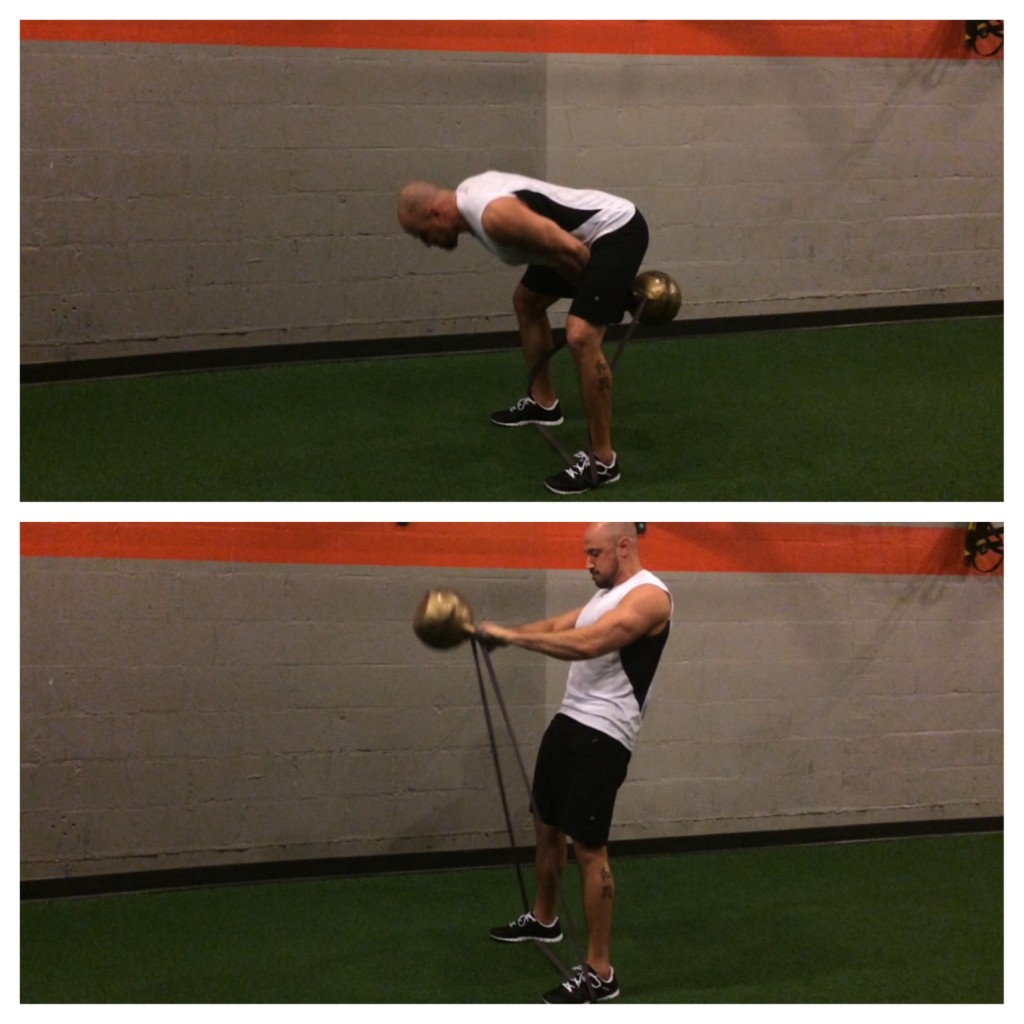
Unfortunately the largest kettlebell I have access to is the 106lb, that is shown. I attach bands to the kettlebell to add resistance. This doesn’t have the exact same feeling of swinging the 203lb’er but it is very similar and teaches a powerful hip extension. I actually prefer the band resisted swing over the heavy kettlebell swing because it is easier for most to control the movement but still must be performed violently because of the added band resistance.

How to set it up (right image first, then left)
Prescription : 5-8 sets of 8 explosive repetitions
Hex Bar Jump Squat
The hex bar jump squat looks similar to the traditional barbell jump squat except weight is held in the hands. This makes it a hip dominant movement compared to the barbell jump squat being more quad dominant. Research has shown that you can achieve greater power outputs with the hex bar jump squat compared to the back loaded barbell jump squat.

Most feel more comfortable with the weight in the hands as opposed to the weight placed on the back, especially if something ‘doesn’t feel right’. It is easier to let go and release the weight rather than trying to dump the bar off your back.
Jump as high as possible on each rep, absorb the impact during landing, and minimize the time you spend in contact with the ground in between each rep.
Prescription: 3-5 sets of 3 explosive repetitions with 50-60% of 1RM hex bar deadlift
Explosive Back Extensions
The explosive back extension should be performed with a slightly rounded upper back and posterior pelvic tilt compared to the traditional back extension with a neutral spine. Perform explosive back extensions with a lighter load or against resistance bands — preferably monster mini band for males and mini band for females.
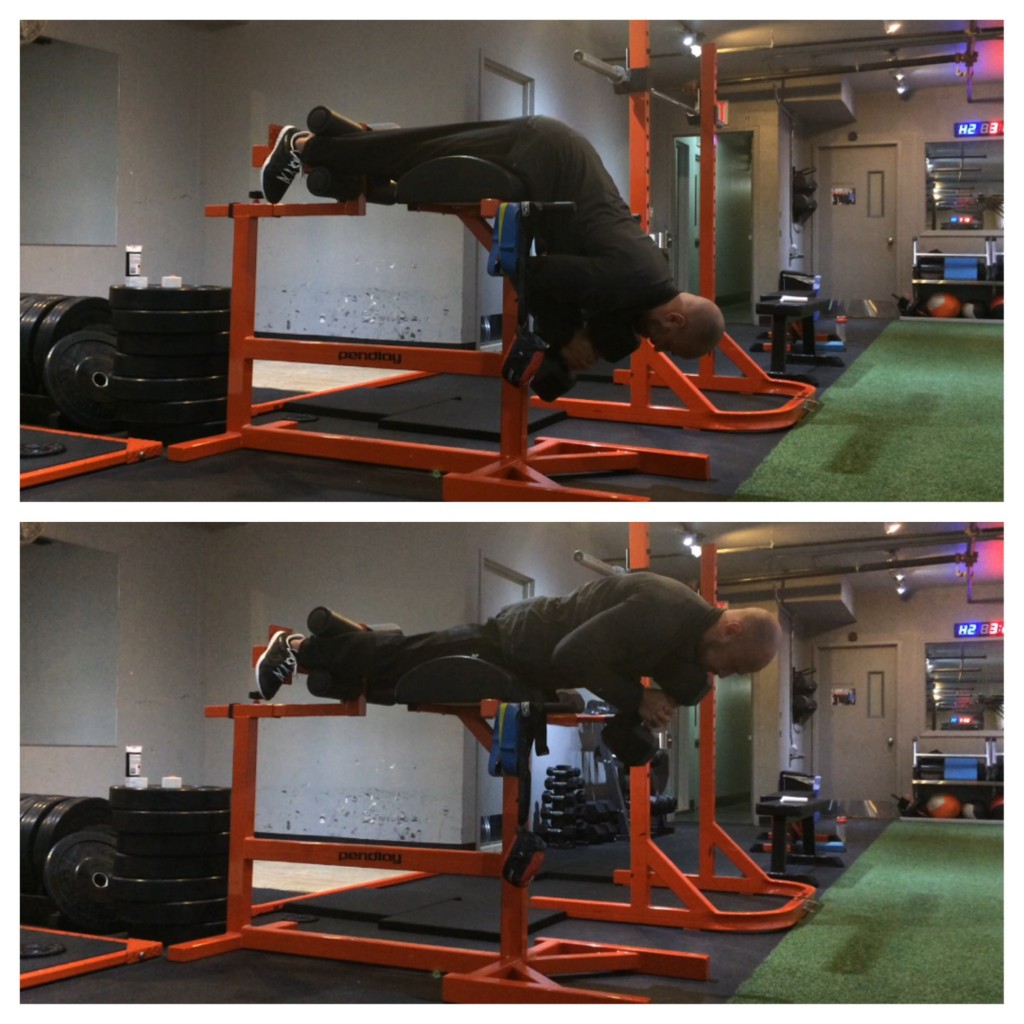
The main focus should be maintaining posterior pelvic tilt, keeping the upper back rounded, driving the hips into the pad as hard as possible and then reversing the movement as quickly as possible.
Prescription: 3-5 sets of eight explosive repetitions with 50% load used for a hard set of 20 reps
Jumping Lunges
Jumping lunges are a great movement to develop power when space and equipment is limited to only bodyweight. The jumping lunge is great because technique can be dialed in to ensure the athlete’s safety. The movement is very easy to learn compared to other single leg plyometrics activities and in most cases very similar to positions found in common field sports.
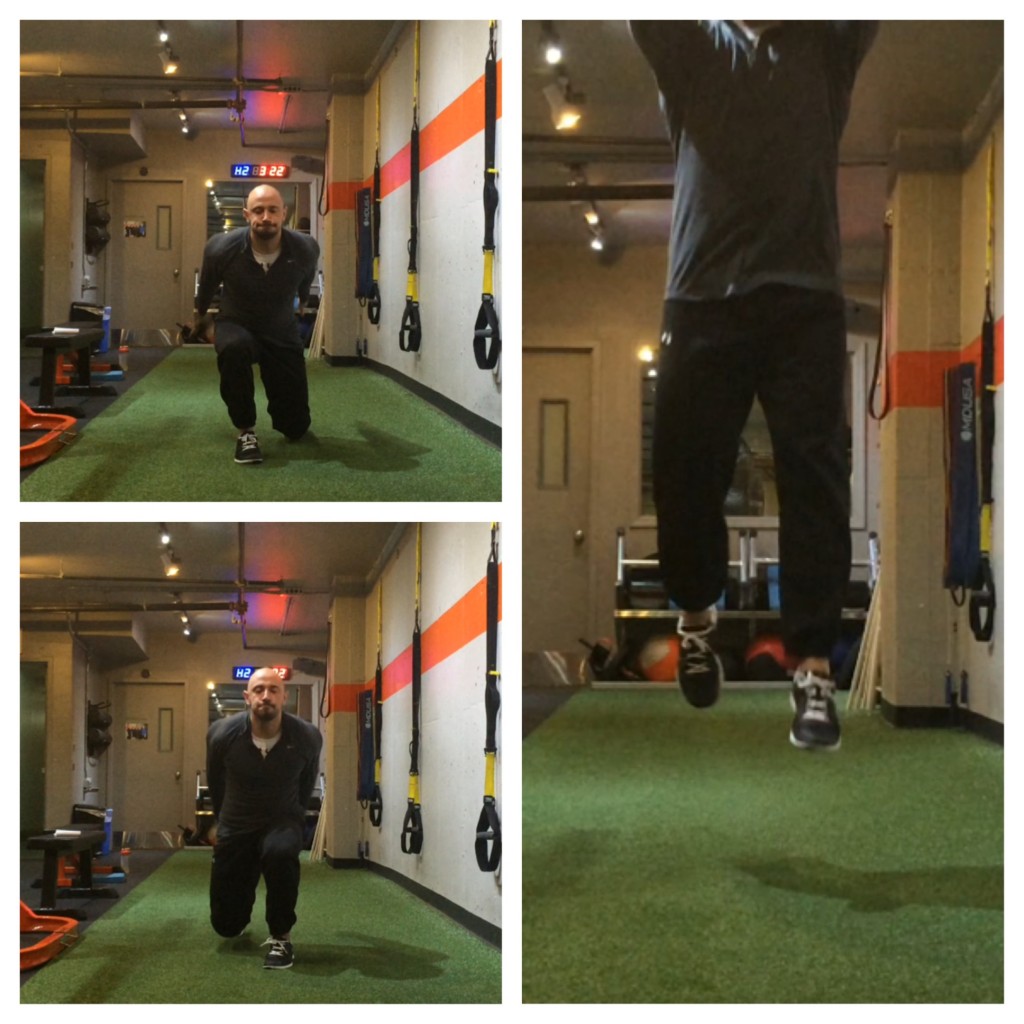
An external load can be used by holding dumbbells or wearing a weight vest if need be. I prefer the weight vest (typically 10-20lbs) compared to dumbbells since the weight vest still allows the use of an arm swing, which is a important component in improving jumping ability.
Prescription: 5-8 sets of 4 repetitions per foot
Sled Sprints
Sled sprints are an amazing movement to include for the development of tremendous lower body power. The sled allows the athlete to strengthen the sprinting muscles while decreasing the overall loading as well as wear and tear on the joints.
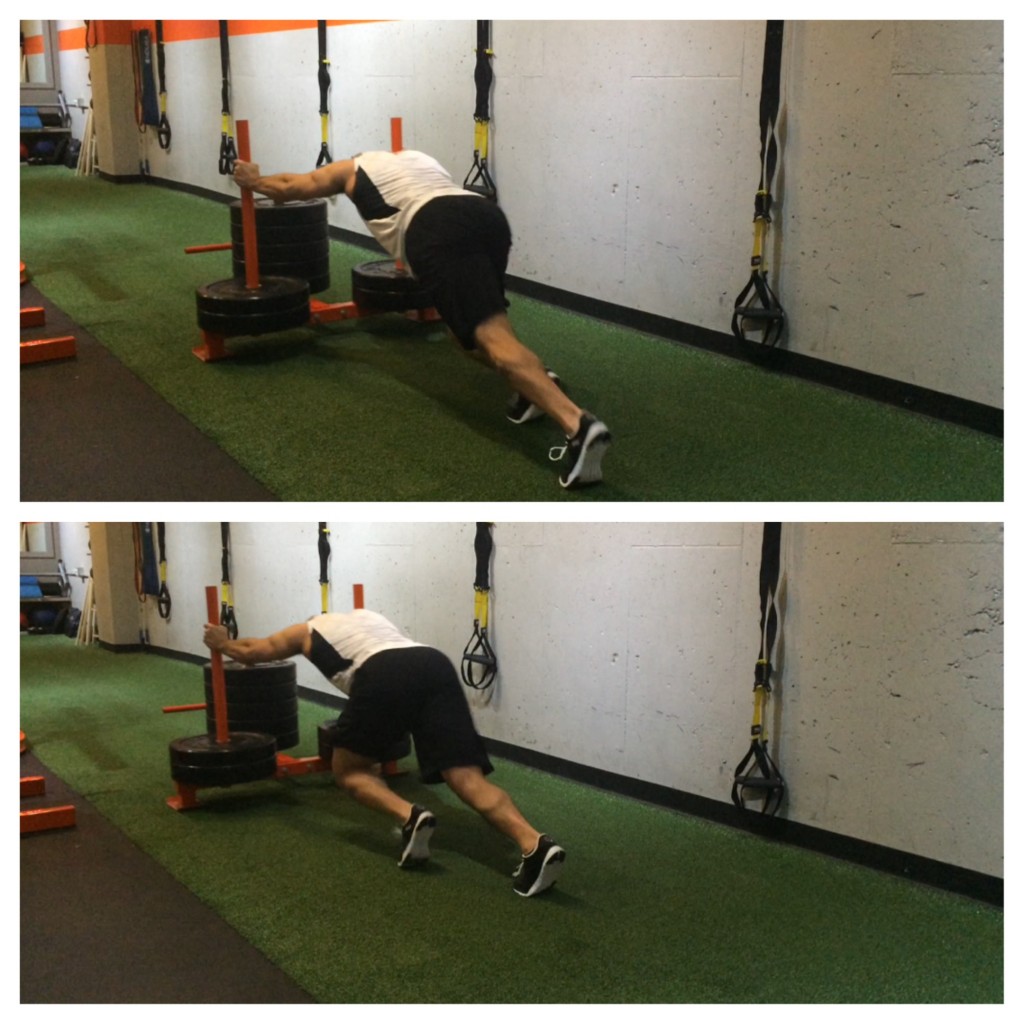
Two common ways to perform sled sprints include:
- Lighter weights which moves quickly
- Very heavy weights which moves slowly
Both must be performed with the intent of moving the sled as fast as humanly possible. The idea behind these two methods is it allows us to train two different parts of the strength continuum. The lighter weights train more speed strength/explosive strength and the heavy weights will train more strength speed/absolute strength.
Prescription: 5-8 sets of 10-20 yards sprints
Putting it all together
When the goal of training is to increase maximal power production it is important to perform these movements in a well-recovered state. This can be accomplished by placing power exercises at the beginning of training or training these movements at a separate time after allowing adequate time for refueling and recovery — For example:
- AM Session – Heavy sled sprints of 5 x 10 yards
- PM Session – Normal strength training regimen later that day with decrease in normal volume
Allow proper time in between sets to ensure full recovery. Training to increase maximal power output is not meant to be performed during a state of fatigue.
Conclusion
Whether you are training for looks, fun or an athletic event it never hurts to be more powerful. Using the movements listed in this article will allow you to train harder while feeling better. Give your body a break and give these joint-friendly power exercises a shot.
Remember ‘QUALITY over QUANITITY ‘
Author Bio
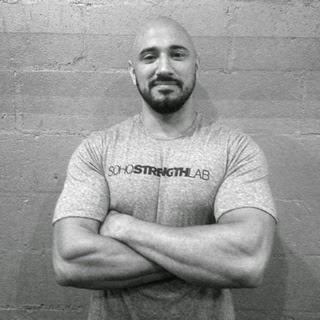
Joey is a strength coach and personal trainer. He is a performance specialist at ‘Soho Strength Lab’, a boutique training studio in New York City and runs an online training business where he helps clients crush their goals. Joey has his Masters degree in Exercise Science and has received his CPPS, CSCS and is Westside Barbell Certified. He is a competitive powerlifter and has been mentored by Louie Simmons at Westside Barbell as well as Bret Contreras at ‘The Glute Lab’.
He provides free content related to all things strength, fitness, health and life on his YouTube Channel ‘Percia Performance‘. Connect with him via Facebook, Instagram, Twitter for a cyber high five. SUBSCRIBE to his free newsletter and receive his 23 page E-book ‘Damage Control for Special Occasions‘ a complete guide for managing fat gain while enjoying special events.






Fantastic article! The other day I was thinking about alternatives to the Olympic Lifts for developing power in athletes and my thoughts kept coming back to hex bar squat jumps and loaded sled sprints. I really believe they are an better way to accomplish triple extension since both are easier to teach and safer to perform.
Quick question Joey. Would you recommend hex bar squat jumps over weighted vest squat jumps? The hex bar squat jump would allow for heavier loads but I feel the weight vest would allow for a more natural movement and the use of the arms during the jump. Or could you use both to train two different parts of the strength continuum like the sled sprints? Like you said before, the lighter weight vest jumps could be used to train speed strength/explosive strength and whereas the hex bar squat jumps could be used to train strength speed/absolute strength.
Once again thanks for the article. It was awesome.
I would use both (just like the sled sprints) depending on where exactly the athlete needs to improve, in relation to the strength continuum, as well as taking into consideration the movement you are trying to enhance.
I’m glad you enjoyed the article!
“My strength comes from the abdomen. It’s the centre of gravity and the source of real power” – Bruce Lee –
No mention of the core in the entire article. Bruce Lee knew you had to be incredibly stabilised particularly through the spine/pelvis region to make full use of your power. The cheetah tells us the same story with 60% of it’s total muscle mass packed onto it’s spine. Cheetahs can walk up to 19 miles (30 km) per day, lending itself to a massive multifidus/pelvic floor workout (developing it’s power/stability). I’m in agreement with the people whom state the multifidus is the only true spinal stabiliser & in my opinion the most important muscle to activate in the entire body mainly for health purposes. So, are the exercises in this article activating the multifidus?, to what extent? & is it enough?, where is the data/proof?. Am I going to be sufficently stabilised during movement after 3-6 months of these workouts?, keep in mind spine/pelvis/pelvic floor/feet & diet all play a crucial role in stability & that repeated heavy lifting can actually weaken the pelvic floor. Stating, “How can squatting a 200Kg barbell not enhance spinal stability” isn’t sufficent evidence of multifidus activation/development.
If you believe, and make the statement, that “the multifidus is the only true spinal stabiliser” the onus is on you to provide the proof. Same with the statement that “repeated heavy lifting can actually weaken the pelvic floor”, which I believe Bret already covered in a piece with Tony G on deadlifts.
Hi Hugh, It was Professor Serge Gracovetsky, Ph.D. who demonstrated that only the Multifidus group has the fiber angles & attachment positions to adequately act as a true erector of the spine. The larger group of muscles, typically referred to as erector spinae acts largely to side-bend the trunk rather than erect it. With regards to the pelvic floor, if repeated heavy lifting was to weaken the pelvic floor that would be groundbreaking, athletic wise (many sources on the net do state this) although as of this moment I’m not arguing either way. If you think about building a house, you obviously need solid foundations or the house will just collapse. Well, the pelvic floor is essentially the body’s foundation (the foundation for the core of the body), so you can see just how important this muscle group really is for stability & stabilising movement. Diet also plays a key role in the strength/weakness of the pelvic floor.
Hi Herbert,
I would have to read Professor Gracovetsky’s however Stuart McGill claims there is no one muscle of the core that is more important than any other. He states that the most important muscle depends on the direction of the load and the stabilisation requirements of the spine at a given time. The multifidus may be the most important muscle in spinal extension however extension may not always be the most important spinal moment required depending on the load.
Valid points and reasoning Herbet. I agree that stating “How can squatting a 200Kg barbell not enhance spinal stability” is not sufficient to stay..so I wont. But as you can see, none of the movements I recommended are similar to a heavy back squat in nature. Your question of being sufficiently stabilized during movement after 3-6 months is a factor depending on your proper execution of the movement. When properly performed they all require a respectable level of strength of the muscles stabilizing the spine.
Also, keep in mind these exercises should NOT be the only movements performed in your training program.
Thanks for the input Herbert.
Outstanding article. Thanks!
Thanks Dunkman
Want power? Its not what you do but how you do it. Mel Siff wrote: “It is interesting to note that depth landings ( I.e. depth jumps without the rebound after landing) alone can also have a significant effect on concentric and eccentric strength. This was shown by Dursenev and Raevsky (1978) who investigated the effect of depth landings from heights of 2m or more onto soft gymnastic mats. Under these conditions, the subjects acquired the ability to display brief muscle tension ( over periods of between 0.028 – 0.061 secs) of a magnitude 1500 – 3500 kgf, i.e. over 20 times bodyweight for heights of up to 3.2 meters. The rationale for using this method was that weight training or other similar methods of resistance training cannot produce this intensity of voluntary effort.” He goes on to say ” It appeared that the main consideration for enhancing strength is not the type of muscle contraction, but the intensity and speed of contraction elicited by the exercise.”
A muscle must elongate before it shortens concentrically. The more powerful this elongation the more powerful the concentric action. Elongation is controlled and dictated by the contraction of the antagonist. These two opposing muscles must act in harmony to produce power and your brain knows if you do or do not have the stability to perform at a given level of power. If you want more power teach opposing muscle groups to communicate better and subject them to high velocity and intensity movements like stepping off a box and landing in an ideal squat or lunge position. Here is a hint… don’t squat on your heals, god please don’t squat on your heals unless you think landing from a height of 3.2 meters, over 9 feet, should be born by your heals instad of invloving another joint like your ankle. Use the balls of your feet.
P.s. that is not a typo it really was up to 20 times bodyweight.
You couldve written your whole post in one word: “plyometrics”. We know them.
The problem is, they are heavily taxing and bear a high risk of short-term and long-term injury when done with bad form, too much volume or even when doing everything right and when simply your joints and ligaments are susceptible! While that is true for all exercises, the margin of error is dramatically low for this kind of exercise.
Plyometrics are the top of the pyramid of your training volume in high level athletes. The exercises Joey presented are for the mass of people and mass of your training volume regarding power. IMO dont even think of regular depth jumps if youre not a professional athlete who puts his health on the line for money.
Great article. I am surprised I have never done hex bar jump squats. I have done them with dumbbells as well as a barbell. The prowler is towards the top of my list of fitness toys I desire. I do however do sled sprints light and heavy but it is a pull and not a push. Your comment about being able to deadlift over 450 pounds and aspiring to swing a 203 pound kettlebell is not realistic to me. I am right there around 450 I deadlifted 445 yesterday all time pr and the biggest kettlebell I have ever swung is only 50 pounds. I think the 106 is good to aim for though. I am sure if I could swing a 203 pound bell I would be able to deadlift much more. As an Australian Rules Football player, gym owner, and personal trainer I love training for power. I started doing snatches about 4 weeks ago and will start the hex bar jump squats next week.
Thanks Nathan..first off Congrats on the new deadlift PR! I really like pulling a heavy loaded sled as well. That is also one of my other favorites. It puts the body in a great position especially for those having trouble getting into a decent forward lean when learning how to properly accelerate.
The 450+ pound deadlift is a reoccurring theme I have seen in those able to properly swing the 203lb’er. I would have a coach proficient in swings take a look and see if there are some errors in your swing they may be able to iron out for you. I am very confident if you can pull 445lb and have a solid hip hinge pattern you can crush some weights well above the 50lb bell.
Let me know how it goes!
It is now becoming clear that many athletes feel that a pure strength and hypertrophy regime hampers their explosiveness and agility. Exploring the ways to train power is highly important yet not widely known. And for the average joe could provide health and hypertrophy benefits that go beyond strength training. Well done guys.
Russian oldies: https://www.youtube.com/watch?v=uHGz3Li2cv4
German shotputter: https://www.youtube.com/watch?v=d4e5cuyqjqw
“Contrast” training: https://www.youtube.com/watch?v=DMyIWBMNBf0
Love those videos Charles — especially the training a Wernor Gunthor. That whole training phase of him on YouTube is very interesting to watch.
I have never see the track work one. That was great!
Where do you online trainers make up all this information. It is like you never trained or workled out. It sounds a lot like someone trying to perform surgery from reading a book rather than from experience.
Joey,
Really enjoyed the article!
What about the B.O.M.B. = Backwards Overhead Med Ball Throw as a total body power developer?
Are you aware of any scales or standards for this exercise in terms of ball weight and distance thrown?
Thanks!
Patrick
Hey Patrick,
I love them! Unfortunately they become an issue in most gyms because of ceiling height. That is one of the reasons I don’t have them in here.
I do have some throw variations that I am writing an article on that should be out within the next couple weeks. Some ‘not so commonly seen’ ones.
As far as scales and standards I haven’t seen anything written up nor do I have the experience with TONS of athletes where I would be able to say ie: if you throw this high you should be able to jump this high or squat this much.
Would be interesting to see though.
Personally I like a ball anywhere from 10, 15 lbs and I prefer throwing for height as opposed to throwing for distance.
P.S. Sorry for the late reply — I don’t get notifications from these so feel free to email me joey@joeypercia.com
The problem with the heavy kettlebell swing is the same problem kettlebells always have: the light one is too light, the next heavier one is way too heavy. Adding band resistance, I guess it’s clever, but it’s too much trouble for me, and it’s still going to be pretty awkward; you don’t know exactly how much resistance you’re adding. You can’t just keep adding weight and keep the reps constant as with barbells; you need a whole roomful of bells 5 kilos apart.
Or–you can get a Lumberjack device, aka Jackhammer, and do lumberjacks, which are very similar to a swing. The main difference is that you drop down into a slight squat as the weight comes up, which makes it a lot like a power snatch, so it’s perfect for developing power. You can load the device in any increments you want. The device itself weighs about 14 pounds, and you can load it to at least 125– but because of its length, the center of its mass is much further away from you, so in a swing, it’s effectively, I’d say at least 50% heavier than a kettlebell of the same weight; at 125 it might be pretty close to that 206 lb kettlebell.
You can see the exercise at
https://www.youtube.com/watch?v=TSEBZ-avIO0
and you can get the device from http://www.monster-grips.com, for around $100 including shipping.
Banded Kettlebell swings. Bam. You just solved a lot lifters lightweight kettlebell issue. I also like the dynamic resistance piece being added into this move, even you do have access to the heaviest bells in the world. It’s just a good idea. Some of us are in gym where they don’t have sleds. Other than going out to the parking lot and pushing around Smart cars, do you have any suggested alternatives? I’ve seen some people using group exercise steps, flipped upside down, and weighted, but that looks a little wonky.
Hey Adam,
Sorry I haven’t seen this! I like hill sprints or pushing a weight plate (obviously not as heavy) as alternative — different feels but relatively comparable.
Hope this helps. Feel free to reach out to me personally so I don’t miss anything joey@joeypercia.com
Hey Joey just stumbled upon your article and it gave me some grand ideas. Been doing banded Swings for some time now and love them but I have a question about swinging I’m general. Would a workout where you do 4-5 sets of 8 starting at the heaviest you can do in good form and pyramiding down in weight each set be effective? My thoughts are you’d start off power being the dominant factor and as you ladder down in weight speed would become the dominant factor so you get the best of both worlds in a session.. but I am speaking as an amateur 🙂
Also
Hey Basil,
I would take a different approach. The benefit of training for power decreases as fatigue sets in so I would still with the heavy weight where you can swing with ‘bad intentions’ and great form.
When that drops move on to something else. Then train for your endurance or with lighter bells at a different time.
That is what I would do. Hope this helps.
Thanks for clarifying that Joey, I’m looking forward to hammering out more banded Swings in my next session 🙂
One last thing with the sled push when working for strength I guess it’s pretty straight forward you push as heavy as you can without sacrificing form but with the lighter pushes for speed & explosive strength what weight should I be aiming for?
Cheers
Basil